10 Stunning No Grass Front Yard Ideas for a Low-Maintenance Landscape
1. Xeriscaping with Native Plants
Transform your front yard with drought-resistant native plants that thrive in your local climate. Xeriscaping reduces water usage by up to 60% compared to traditional lawns while creating a vibrant, colorful industry. Choose plants like lavender, yucca, and ornamental grasses that require minimal irrigation once established. This approach not only saves time on maintenance but also supports local wildlife and pollinators.
2. Gravel and Rock Gardens
Create a sophisticated rock garden using different sizes and colors of gravel, pebbles, and decorative stones. This low-maintenance option provides excellent drainage and prevents weed growth when installed with proper weed barrier fabric. Incorporate larger boulders as focal points and add drought-tolerant succulents or alpine plants in strategic spots for pops of color and texture.
3. Elegant Paver Designs
Replace your lawn with stylish pavers in geometric patterns or flowing designs. Modern concrete pavers come in many colors, textures, and shapes to complement your home’s architecture. Leave small spaces between some pavers to plant creeping thyme or moss, which adds softness while requiring minimal water. This option creates a clean, structured look that’s perfect for contemporary homes.
4. Mediterranean-Inspired Courtyard
Design a Mediterranean-style courtyard with terracotta pots, olive trees, and drought-resistant herbs like rosemary and lavender. Add a small water feature or fountain as a focal point, surrounded by decomposed granite or flagstone. This approach creates an inviting entrance that needs little watering while offering pleasant fragrances and year-round interest.
5. Succulent Garden Display
Showcase a stunning collection of succulents in varying heights, colors, and textures. These water-wise plants store moisture in their leaves and require almost no maintenance once established. Create striking arrangements with varieties like echeveria, agave, and sedum planted directly in the ground or in decorative containers. Mulch with decorative gravel to complete the look and further reduce water needs.
6. Japanese-Inspired Zen Garden
Transform your front yard into a peaceful retreat with a minimalist Japanese garden featuring carefully raked gravel, strategically placed rocks, and pruned evergreen shrubs. This design philosophy emphasizes harmony and tranquility through simple elements and thoughtful spacing. Add a stone path, bamboo accents, and perhaps a small maple tree for a meditation-friendly space that requires minimal upkeep.
7. Outdoor Living Room
Convert your front yard into a functional living space with weather-resistant furniture, a pergola for shade, and container plants for visual interest. Use permeable pavers or decomposed granite as flooring and install solar lighting for evening ambiance. This creates an extension of your home that encourages outdoor gatherings while eliminating mowing and watering needs.
8. Artificial Turf Installation
Install high-quality artificial grass for the look of a perfect lawn without the maintenance. Modern synthetic turf is incredibly realistic, stays green year-round, and can last up to 20 years. This option eliminates mowing, watering, and fertilizing while providing a soft surface for children and pets. Combine with stone borders and drought-tolerant plantings for a balanced industry approach.
9. Edible Front Yard Garden
Replace your lawn with an attractive edible industry featuring fruit trees, berry bushes, and ornamental vegetables. Use raised beds with gravel pathways between them for a neat appearance that neighbors will appreciate. This productive approach provides fresh produce, reduces grocery bills, and creates a uniquely functional front yard that changes with the seasons.
10. Hardscaped Patio with Container Garden
Create a sophisticated front yard patio using stamped concrete or natural stone surrounded by large decorative containers filled with seasonal plants. This design allows you to change your garden display throughout the year without major replanting. Add a small fire pit or water feature as a focal point to elevate the space from merely functional to truly extraordinary.
1. Xeriscaping: Desert-Inspired Front Yard Design
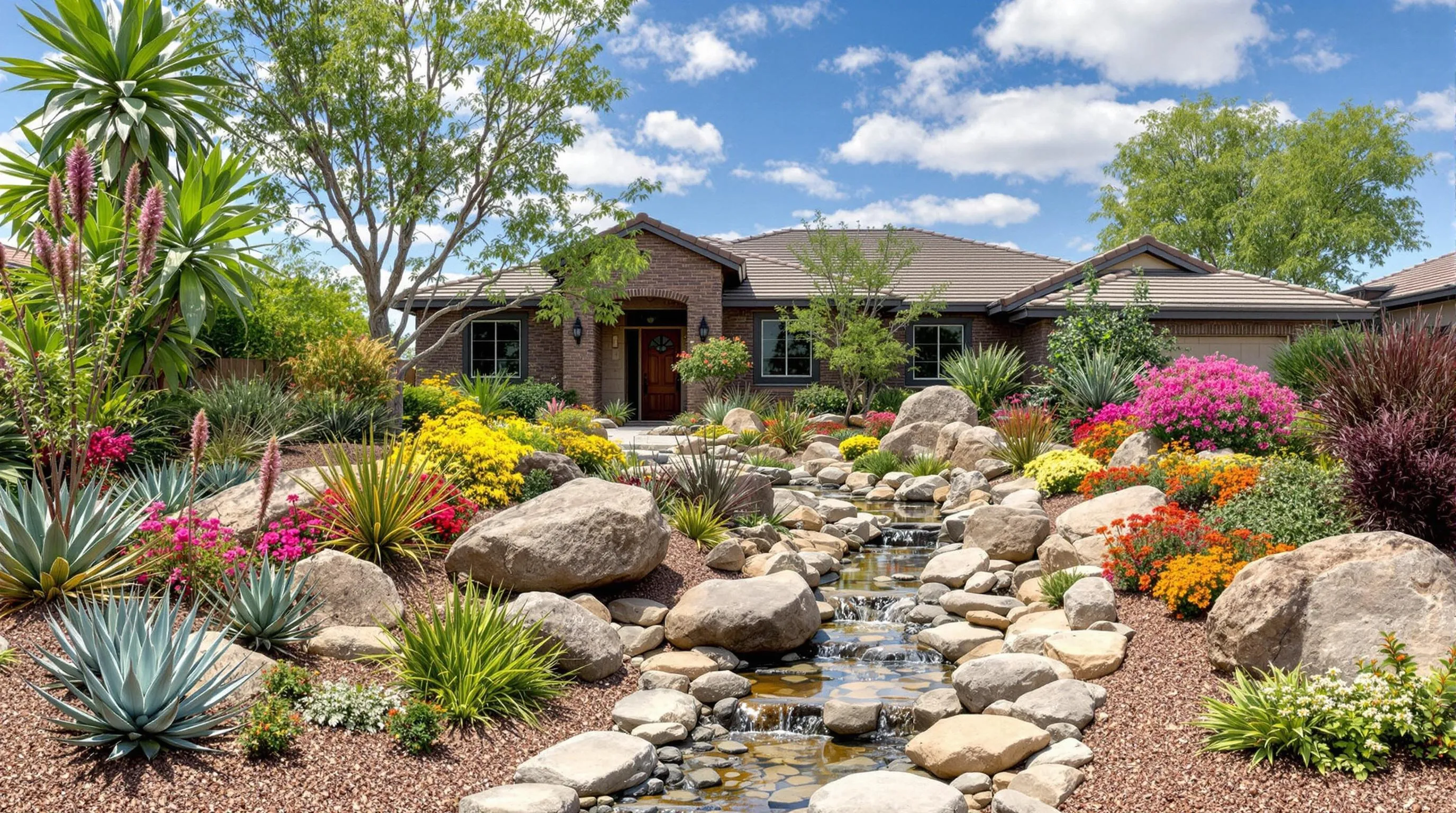
Xeriscaping transforms your front yard into a stunning, water-efficient industry inspired by desert aesthetics. This approach reduces water consumption by up to 60% compared to traditional lawns while creating a distinctive, low-maintenance outdoor space that stands out in your neighborhood.
Native Drought-Resistant Plants to Consider
Incorporate native drought-resistant plants to create a xeriscaped front yard that thrives in your local climate. Choose agave, which offers architectural interest with its dramatic spiky leaves in varieties like Blue Glow and Americana. Plant ornamental grasses such as Mexican Feather Grass or Blue Fescue to add movement and texture. Add visual interest with flowering perennials like Black-Eyed Susan, Coneflower, and Russian Sage that attract pollinators while withstanding hot, dry conditions. Include aromatic herbs such as lavender, rosemary, and thyme that serve dual purposes as beautiful plants and culinary ingredients. For year-round structure, incorporate small shrubs like Texas Sage, Coyote Brush, or Manzanita that require minimal watering once established.
Decorative Rock Arrangements for Visual Interest
Create striking visual focal points with thoughtfully arranged decorative rocks in your xeriscaped yard. Select varying sizes of rocks—from large boulders to small pebbles—to establish depth and dimension throughout the industry. Use different colored stones like warm-toned sandstone, cool slate gray, and rich terracotta to complement your home’s exterior and create visual contrast. Arrange larger specimen rocks as anchor points, then surround them with smaller stones to create natural-looking groupings. Install dry creek beds with smooth river rocks to manage water runoff during occasional rainfall while adding an artistic element. Incorporate crushed gravel or decomposed granite for pathways that provide practical access through your yard while maintaining the desert aesthetic. Position rocks strategically to create microclimates that shelter sensitive plants from harsh elements, maximizing plant survival in your water-wise industry.
2. Mediterranean Gravel Gardens with Olive Trees and Herbs
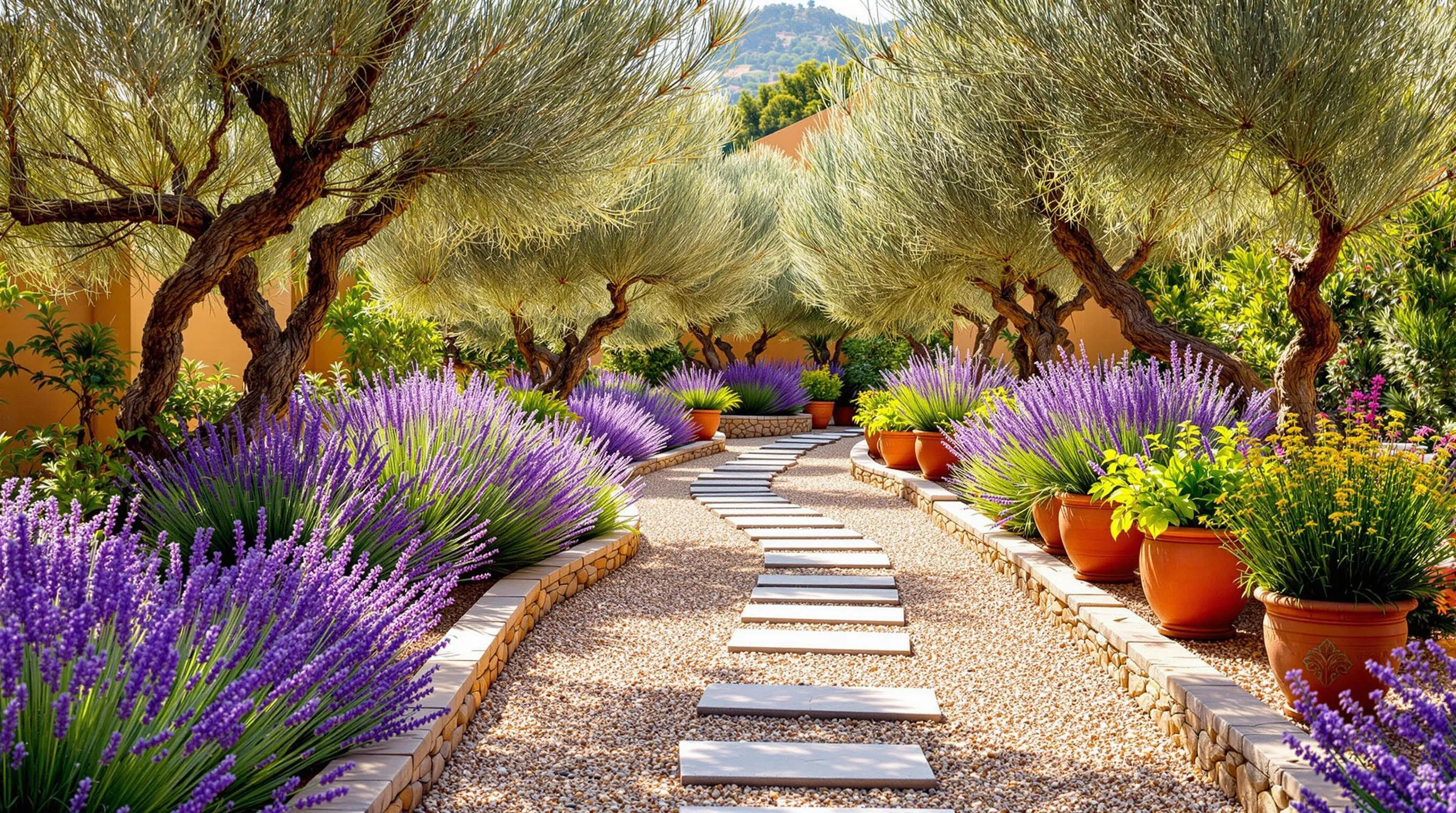
Transform your front yard into a sun-drenched Mediterranean oasis by combining elegant gravel with iconic olive trees and aromatic herbs. This design creates a sophisticated, low-maintenance industry that thrives in hot, dry conditions while offering year-round visual interest and fragrance.
Creating Defined Pathways with Different Gravel Sizes
Establish structure in your Mediterranean garden by creating defined pathways using varied gravel sizes. Use larger stones (3/4″ to 1″) for main walkways to provide stable footing, while incorporating smaller pea gravel (1/4″ to 1/2″) in planting areas for better drainage. Install sturdy metal or stone edging to maintain clean borders between pathways and planting beds. Consider incorporating stepping stones or pavers at key intervals along gravel paths to create rhythm and practical walking surfaces. Different colored gravels—from warm honey tones to cool grays—can create visual zones that guide visitors through your garden while complementing your home’s exterior palette.
Drought-Tolerant Mediterranean Plants for Color
Populate your gravel garden with drought-resistant Mediterranean varieties that provide texture and seasonal color. Plant lavender clusters for purple blooms and calming fragrance, interspersed with silvery-gray santolina and the bright yellow flowers of Jerusalem sage. Add vertical interest with Italian cypress or rosemary shrubs trimmed into columns. For ground cover, use creeping thyme that releases aromatic oils when stepped upon. Position dwarf olive trees as focal points—they offer silvery foliage year-round and require minimal water once established. Group terra cotta pots planted with cascading herbs like oregano and marjoram near entrances to create welcoming fragrant moments. This plant palette thrives in full sun and poor soil conditions, making it perfect for challenging front yard environments.
3. Modern Hardscaping with Concrete Pavers and Planters
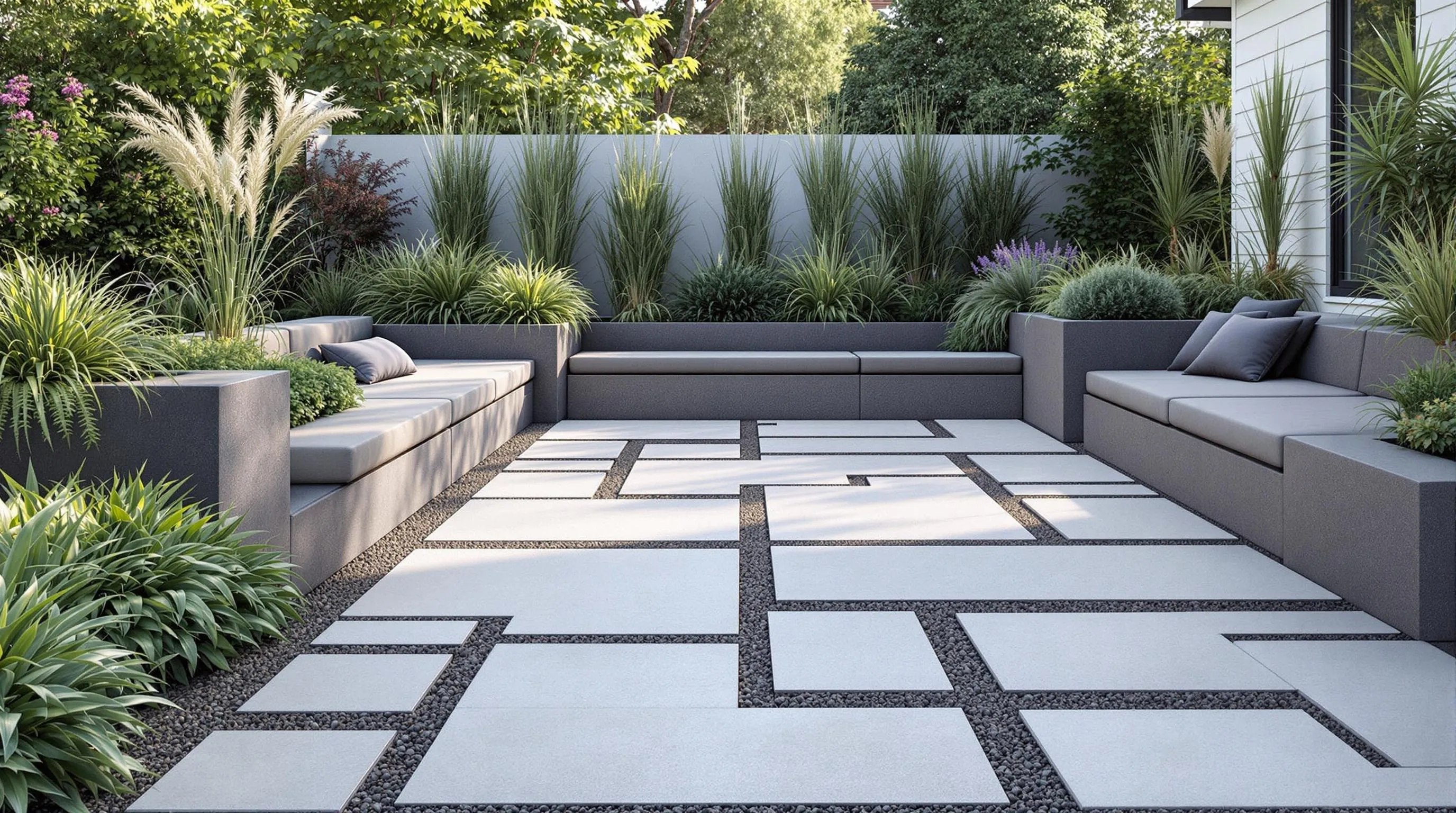
Transform your front yard into a sleek, contemporary space with modern hardscaping elements. Concrete pavers offer a clean, structured aesthetic while requiring virtually no maintenance compared to traditional lawns.
Geometric Patterns for Contemporary Appeal
Create visual interest in your front yard by arranging concrete pavers in bold geometric patterns. Choose large-format rectangular pavers for a minimalist look or mix different sizes for more ever-changing designs. Opt for cool gray tones for a modern aesthetic or warm earth tones to complement your home’s exterior. The negative space between pavers can be filled with small pebbles, crushed granite, or drought-tolerant ground covers like creeping thyme or sedum. This approach creates a sophisticated design statement while eliminating the need for mowing, watering, and fertilizing.
Incorporating Built-in Seating Areas
Maximize your front yard’s functionality by integrating built-in concrete seating walls or benches. These architectural elements serve dual purposes – defining your hardscaped space while providing convenient seating for conversations with neighbors or quiet moments outdoors. Pair your concrete seating with strategically placed planters filled with architectural plants like ornamental grasses, agave, or sculptural succulents. For added comfort, top concrete benches with weather-resistant cushions in colors that complement your home’s exterior. This hardscaped approach creates an inviting, low-maintenance front yard that serves as both a visual anchor and a practical outdoor living space.
4. Japanese-Inspired Rock Gardens with Minimal Maintenance
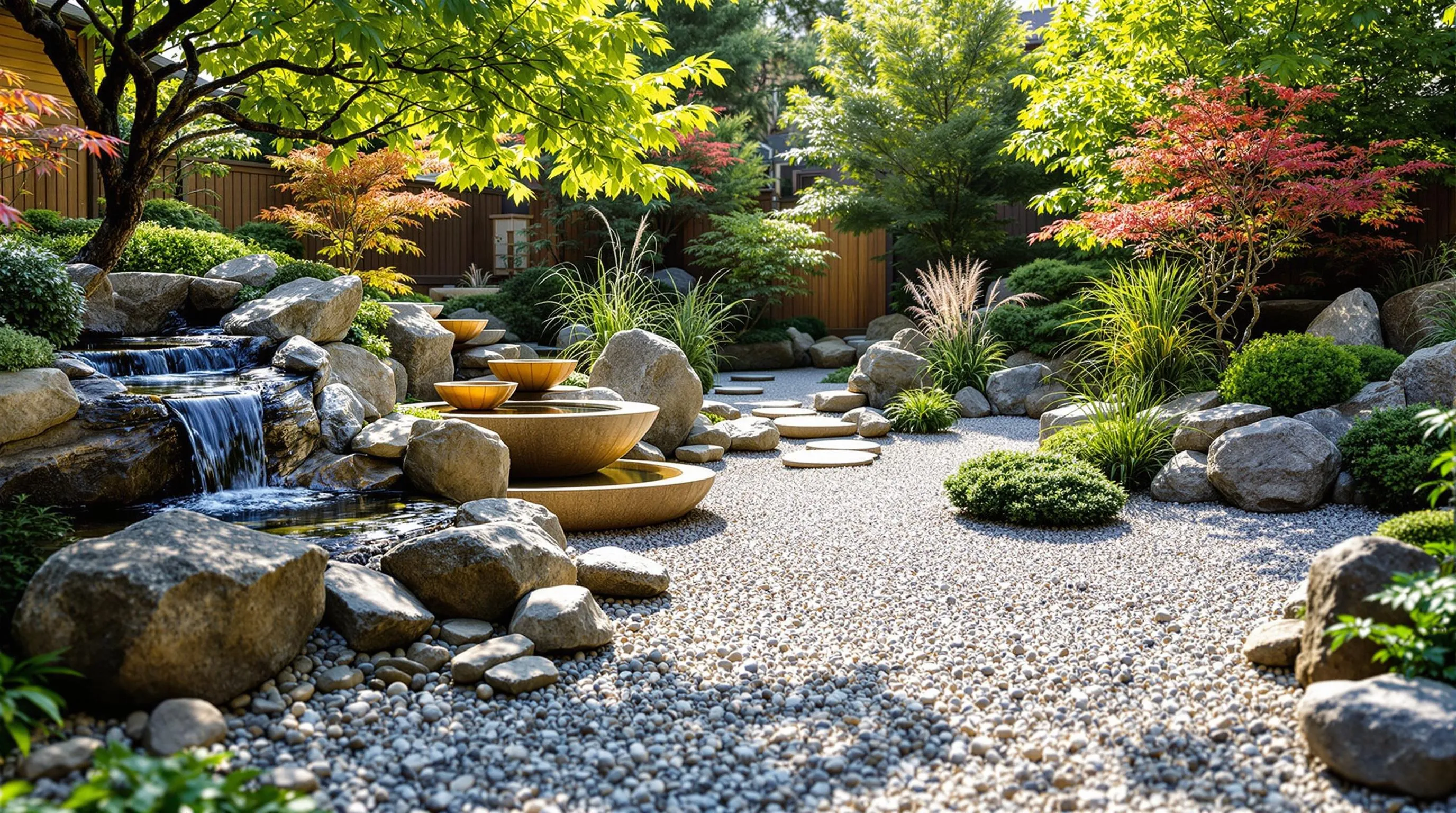
Transform your front yard into a serene Japanese-inspired rock garden that requires minimal upkeep while creating a striking visual impact. These thoughtfully designed spaces embrace the philosophy of “less is more,” focusing on balance, simplicity, and natural elements to create a peaceful industry that stands out in any neighborhood.
Strategic Placement of Boulders and Pebbles
Create visual impact through carefully positioned rock elements that serve as the foundation of your Japanese garden. Select a variety of boulders in different sizes—typically in odd numbers like three or five—to establish focal points throughout your yard. Position larger stones partially buried to appear as if they’ve emerged naturally from the earth. Surround these anchoring elements with meticulously raked pebbles or fine gravel in concentric patterns that represent ripples in water. Use at least 2-3 inches of crushed granite or river rock as your base material, adding weed barrier fabric underneath to prevent unwanted growth. Incorporate moss-covered rocks in shadier areas for an aged, established appearance that suggests permanence and tranquility.
Adding Zen Elements with Water Features
Enhance the meditative quality of your rock garden with subtle water elements that engage multiple senses. Install a small bamboo fountain (shishi-odoshi) that creates gentle sounds as it fills and empties, providing both visual interest and soothing acoustics. For a more minimalist approach, consider a shallow stone basin (tsukubai) that collects rainwater and attracts birds. Even a dry stream bed created with smooth river stones can symbolize flowing water without actual maintenance requirements. Position these water elements where they’ll catch morning light or can be viewed from your home’s windows. Complement these features with carefully pruned Japanese maples, dwarf conifers, or ornamental grasses that require minimal trimming while providing seasonal color changes that enhance your garden’s year-round appeal.
5. Native Wildflower Meadows Instead of Traditional Lawns
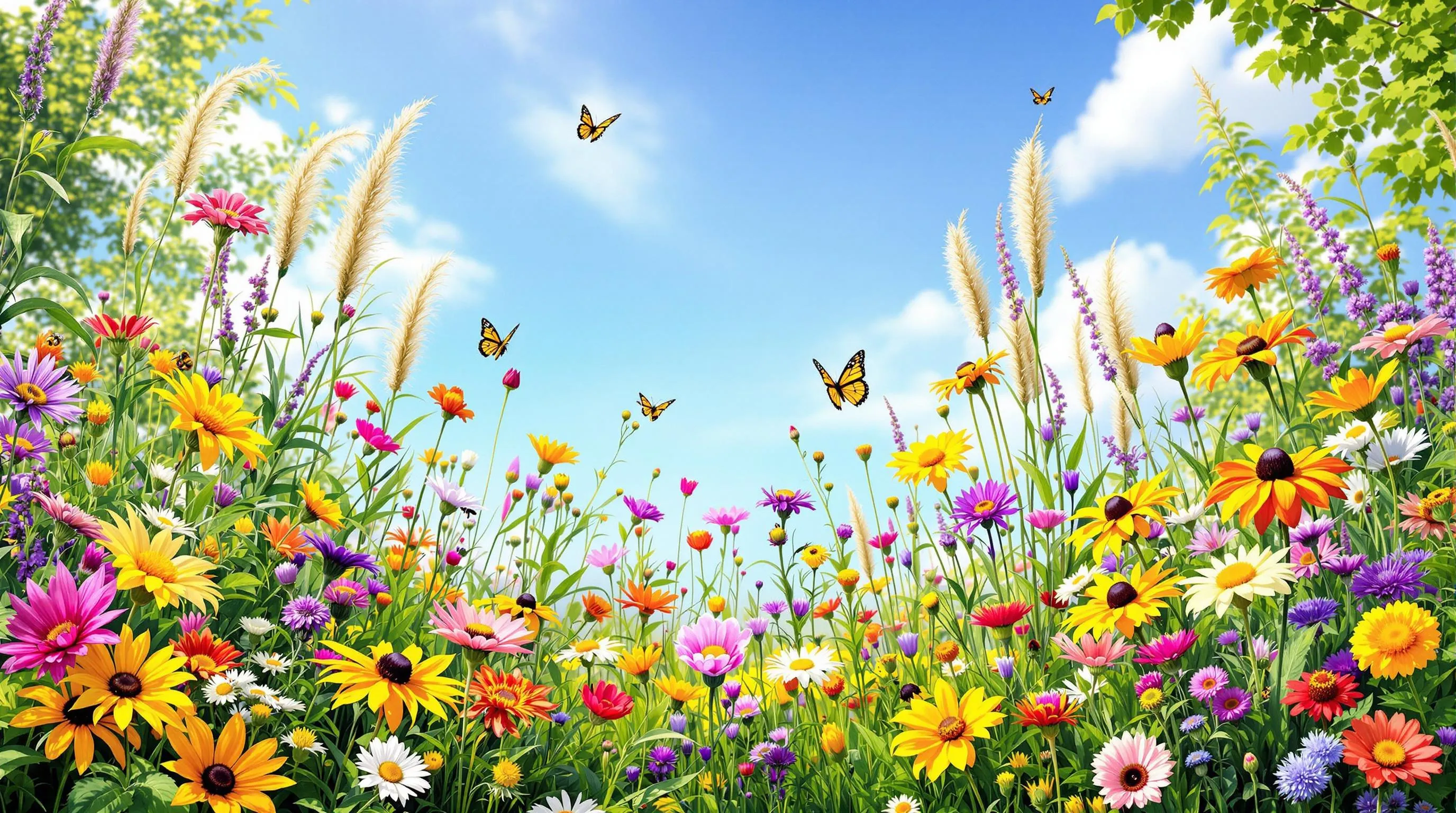
Transform your front yard into a vibrant network by replacing your traditional lawn with a native wildflower meadow. This eco-friendly alternative creates a stunning, ever-changing industry that requires minimal maintenance while providing important environmental benefits.
Seasonal Color Changes Without Mowing
Native wildflower meadows offer spectacular visual interest throughout the year without demanding weekly mowing. In spring, early bloomers like columbine and coreopsis emerge with bright yellows and purples. Summer brings the bold colors of black-eyed Susans, coneflowers, and bee balm that create a breathtaking display. Fall introduces golden rudbeckias and deep purple asters that sway gracefully in autumn breezes. Even winter presents its own beauty with seed heads and ornamental grasses providing texture and movement against snow or frost. You’ll enjoy a continuously evolving industry that needs just one annual cutting rather than weekly lawn maintenance, saving you approximately 70 hours of yard work annually.
Supporting Local Pollinators and Wildlife
A native wildflower meadow transforms your front yard into a crucial habitat for local wildlife. Butterflies, bees, and hummingbirds will frequent your property, drawn to the nectar-rich blooms that evolved specifically to support them. Native songbirds feast on the seeds and insects that thrive in this natural environment. Research shows that native meadows can support up to 50 times more beneficial insects than traditional lawns. Creating a meadow is straightforward—simply prepare your soil, select a seed mix exact to your region, sow in early spring or fall, and water until established. Within just one growing season, you’ll enjoy a low-maintenance, environmentally valuable industry that stands out beautifully in your neighborhood while contributing to local biodiversity conservation.
6. Succulent Gardens for Arid Climate Front Yards
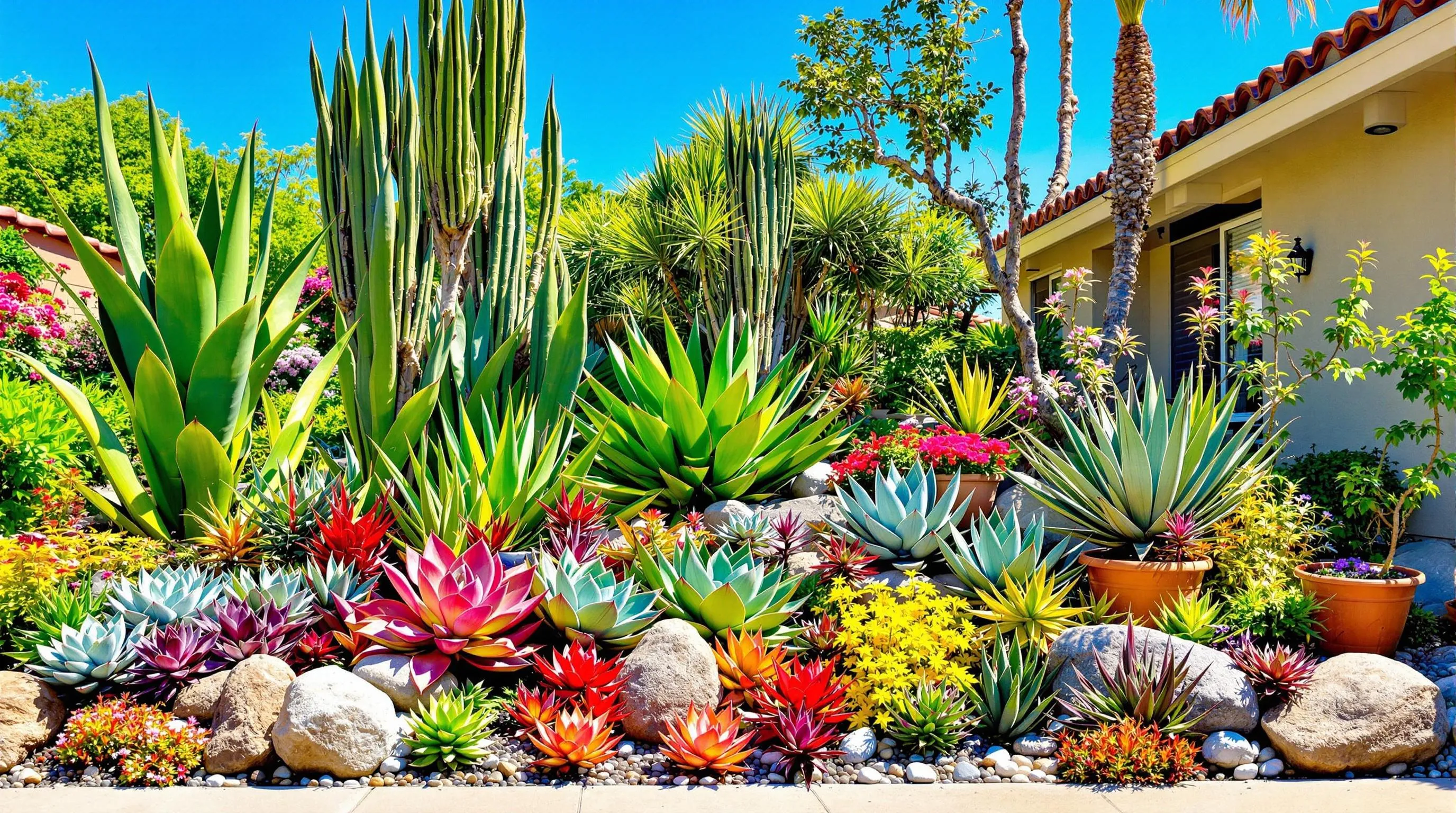
Transform your water-thirsty front yard into a striking desert oasis with a succulent garden that thrives in arid conditions. Succulents offer remarkable diversity in shapes, sizes, and colors while requiring minimal maintenance and water—making them perfect for drought-prone regions.
Creating Height and Texture Variation
Design your succulent garden with compelling visual depth by incorporating plants of varying heights and textures. Position taller varieties like Euphorbia or Agave attenuata toward the back or center as dramatic focal points. Surround these with mid-sized options such as Echeverias and Aloes, then fill remaining spaces with ground-hugging selections like Sempervivums and Sedum. Add textural contrast by mixing spiky specimens (Agave americana) with rosette forms (Aeoniums) and trailing varieties (String of Pearls). This layered approach creates a ever-changing industry that draws the eye through the garden while maximizing your limited space.
Colorful Succulent Combinations for Visual Impact
Elevate your front yard’s curb appeal by strategically pairing succulents with complementary colors. Create stunning color stories with blue Senecio serpens against orange Crassula capitella ‘Campfire’ or purple Echeveria ‘Perle von Nürnberg’ alongside lime-green Sedum ‘Lemon Coral’. For year-round interest, select varieties that transform colors seasonally—like Sempervivum ‘Cosmic Candy’ which shifts from green to deep burgundy in cooler weather. Arrange your colorful combinations in decorative containers or striking rock gardens to create focused visual moments throughout your yard. This approach delivers maximum impact with minimal resources, particularly when grouped in odd-numbered clusters for a natural, designer-worthy appearance.
7. Courtyard-Style Entrance with Potted Plants and Pavers
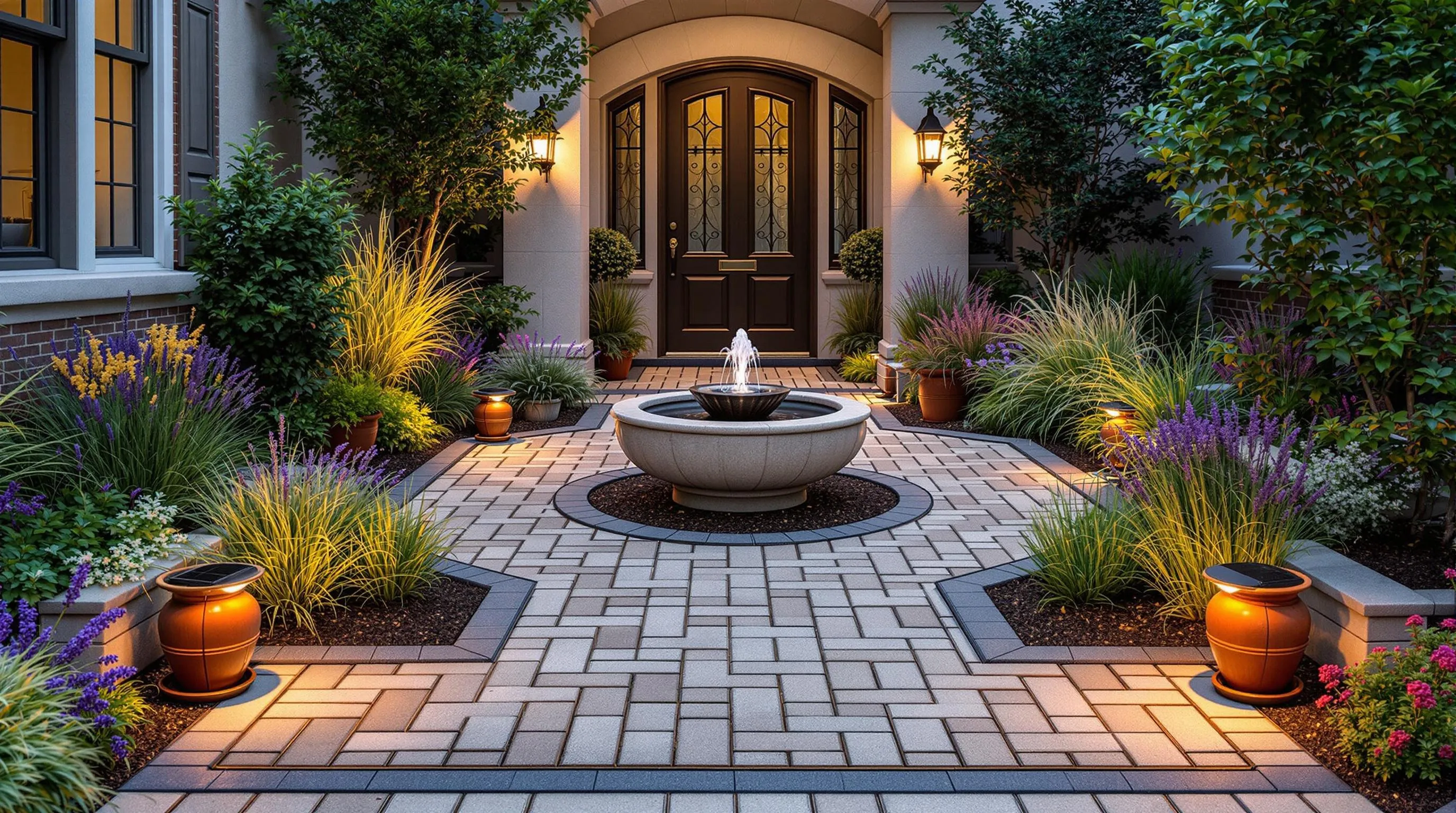
Transform your front yard into an elegant courtyard by combining decorative pavers with strategically placed potted plants. This Mediterranean-inspired approach creates a welcoming entrance that’s both sophisticated and low-maintenance. The beauty of this design lies in its perfect balance of hardscaping and greenery, offering structure while still maintaining organic elements.
The foundation of a courtyard-style entrance begins with high-quality pavers arranged in an interesting pattern—herringbone, basket weave, or circular designs all work beautifully. Leave strategic gaps between some pavers where you can plant creeping thyme or moss to soften the hardscape. Around the perimeter, place varying heights of weather-resistant containers filled with drought-tolerant plants like lavender, rosemary, and ornamental grasses. This creates a framed entryway that guides visitors while providing visual interest throughout the seasons.
Consider adding a focal point such as a small bubbling fountain or an ornamental tree in a large decorative pot at the center of your courtyard. This draws the eye and creates a sense of place. For evening ambiance, integrate solar-powered path lights or string lights overhead if you have supporting structures. The beauty of this approach is its adaptability—you can rearrange the potted elements seasonally or as your taste evolves, without the commitment of in-ground plantings.
8. Ground Cover Alternatives That Thrive with Minimal Care
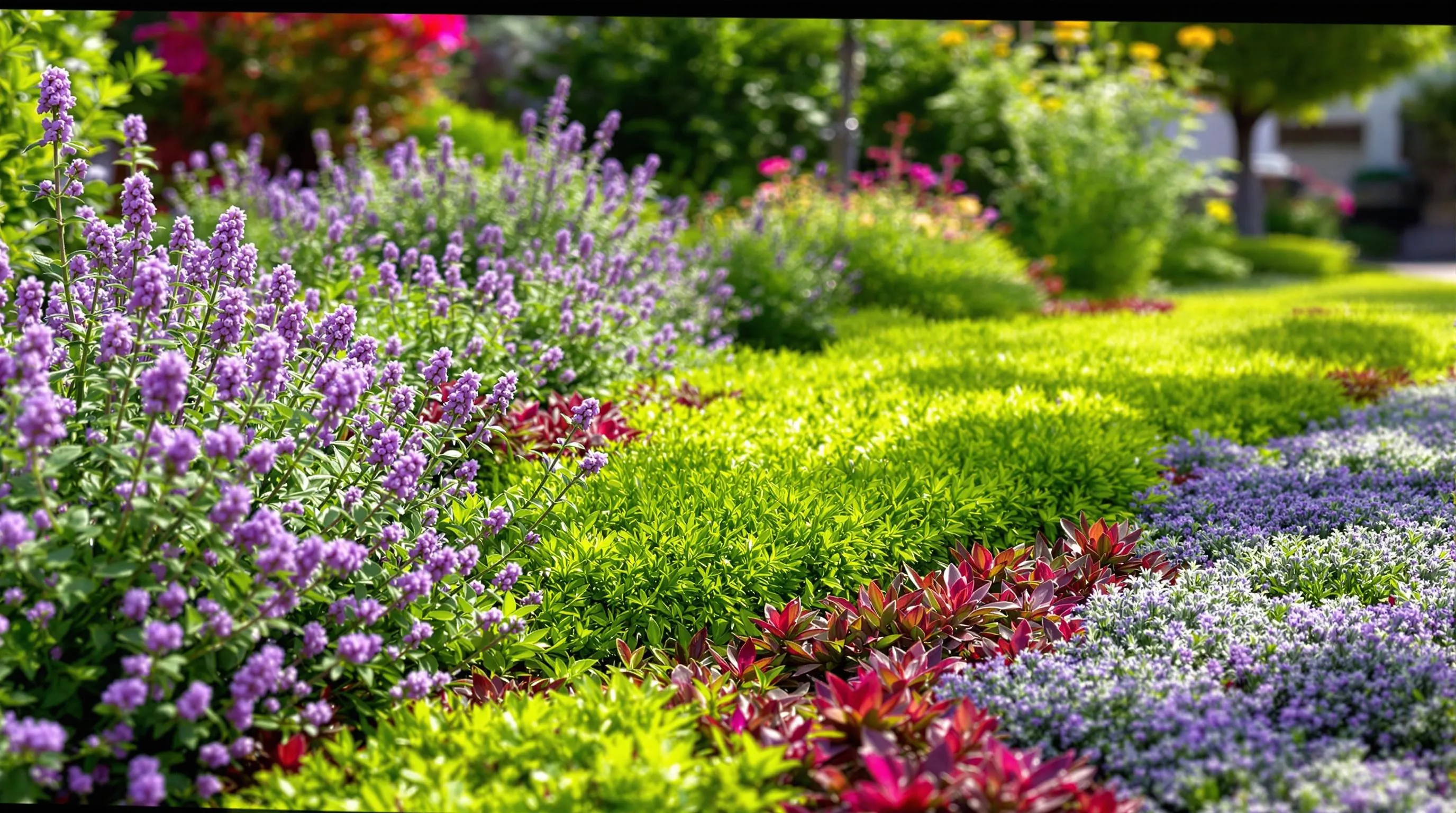
Ground covers offer an excellent grass-free solution for your front yard, providing lush coverage while requiring significantly less maintenance than traditional lawns. These versatile plants spread horizontally, choking out weeds and creating a seamless carpet of greenery or colorful blooms.
Creeping thyme transforms ordinary spaces into aromatic wonderlands with minimal effort. This drought-tolerant ground cover releases a pleasant scent when stepped on and produces tiny purple flowers that attract pollinators. Plant it between stepping stones or as a lawn replacement where you’ll enjoy its fragrance during summer strolls. Creeping thyme thrives in zones 4-9 and requires just occasional watering once established.
Sedum (stonecrop) offers exceptional drought tolerance with fascinating textures and colors. Low-growing varieties like Sedum spurium ‘Dragon’s Blood’ create a dense mat that effectively blocks weeds while displaying red-tinged foliage and star-shaped pink flowers. These succulents store water in their leaves, making them perfect for hot, dry areas where other plants struggle. Most sedums perform best in zones 3-9 with full to partial sun.
Moss creates a velvety, emerald carpet in shady areas where grass typically struggles. Unlike traditional lawns, moss requires no mowing, minimal watering, and thrives in acidic, compacted soils. Species like sheet moss (Hypnum) and cushion moss (Leucobryum) create different textures that can transform your yard into a woodland-inspired retreat. For best results, keep moss moderately moist during establishment.
Clover delivers multiple benefits while requiring minimal care. White clover (Trifolium repens) stays naturally short at 2-8 inches tall, eliminating the need for mowing. As a nitrogen-fixing plant, it improves soil health without fertilizers. Its small white flowers attract beneficial insects, and it remains green even during moderate drought periods. Clover thrives in zones 3-10 and tolerates light foot traffic, making it practical for family homes.
For high-traffic areas, consider walkable ground covers that can withstand frequent foot traffic while maintaining their beauty. Blue star creeper (Isotoma fluviatilis) creates a dense mat of tiny blue flowers that can handle moderate foot traffic and grows just 1-2 inches tall. Mondo grass (Ophiopogon japonicus) forms tufts of grass-like foliage that withstand occasional walking and never needs mowing. Creeping Jenny (Lysimachia nummularia) offers chartreuse foliage that brightens shady pathways and tolerates light foot traffic while spreading quickly.
Incorporate several compatible ground covers in your design for year-round interest. Plant drought-tolerant sedums in sunny spots, thyme along pathways for fragrance, and moss in shaded areas to create a diverse, low-maintenance industry that eliminates mowing while improving your home’s curb appeal.
9. Edible Front Yard Landscapes with Herbs and Vegetables
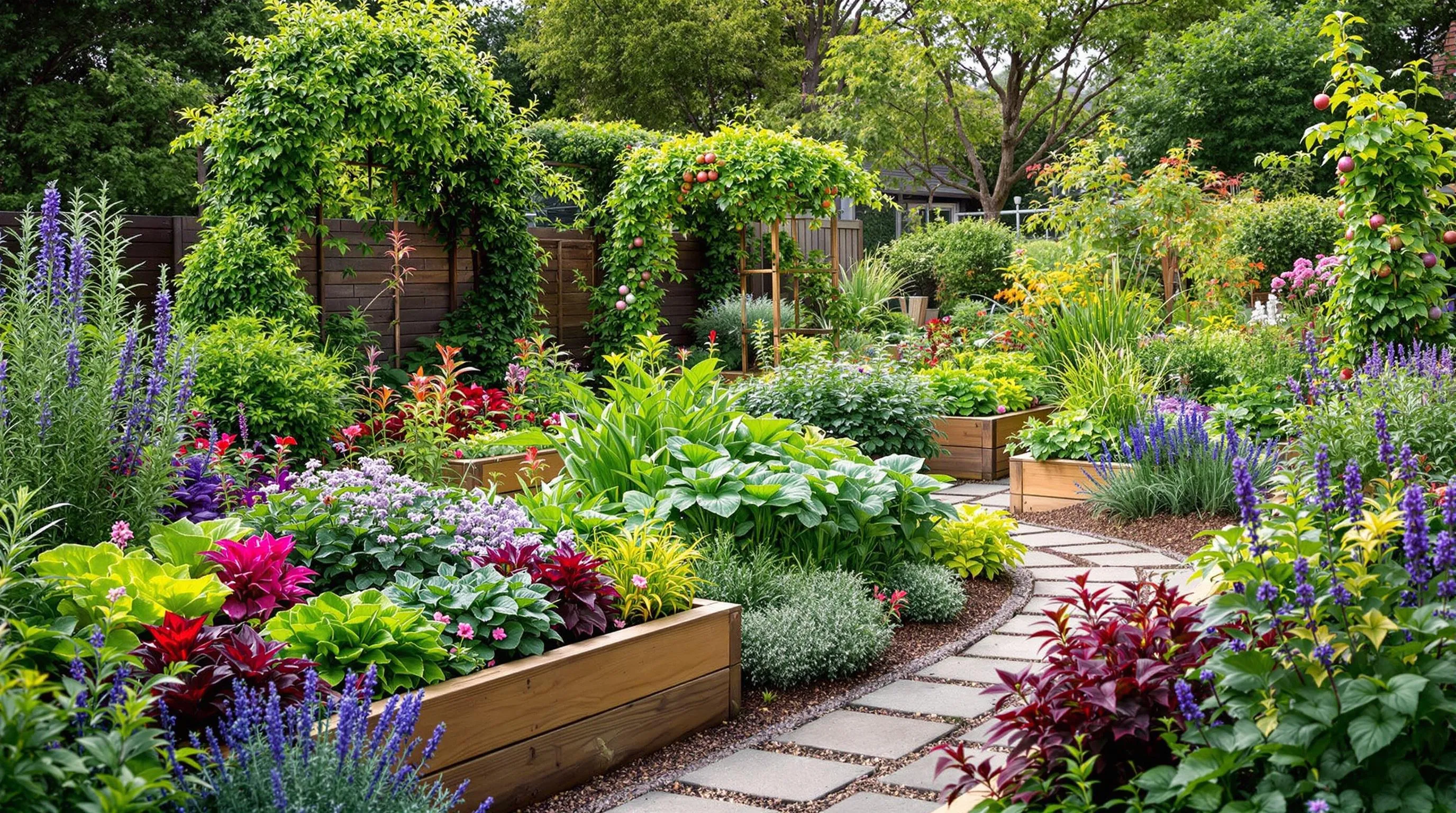
Transform your front yard into a productive and beautiful space by incorporating edible landscaping. This practical approach combines ornamental appeal with food production, creating a yard that’s both visually stunning and functional.
Ornamental Edibles for Curb Appeal
Select visually striking edible plants that double as ornamentals to create a front yard that’s both beautiful and productive. Rainbow chard offers vibrant stems in gold, pink, and crimson that rival traditional flowers for visual impact. Purple basil and bronze fennel provide dramatic foliage color while delivering fresh herbs for your kitchen. Consider incorporating fruit-bearing trees like dwarf apple or decorative blueberry bushes with their seasonal white flowers and fall foliage. Artichokes develop stunning architectural form with their silvery foliage and dramatic purple flower heads when left unharvested. Line walkways with fragrant herbs like rosemary, thyme, and lavender that release pleasant aromas when brushed against while controlling foot traffic patterns. Plant nasturtiums, pansies, and calendula for edible flowers that add splashes of color throughout your edible industry while attracting beneficial pollinators.
Raised Bed Designs for Front Yard Food Production
Incorporate strategically placed raised beds to create structure and maximize growing space in your front yard food garden. Cedar or redwood raised beds in clean geometric patterns establish a formal framework that keeps your edible industry looking intentional rather than chaotic. Build beds with varying heights (12-24 inches) to create visual interest while making maintenance easier on your back. Install drip irrigation systems hidden beneath mulch to ensure consistent watering without unsightly hoses. Edge pathways between beds with brick, stone, or steel to define spaces clearly and prevent grass encroachment. Position taller plants like trellised tomatoes or pole beans toward the back of your property, with progressively shorter plants moving toward the street for perfect visibility. Add permanent structures like obelisks or tuteurs for climbing plants that provide vertical interest even in winter months. For year-round appeal, incorporate evergreen herbs like sage and rosemary to anchor beds that might otherwise look bare during colder seasons.
10. Rain Garden Designs for Water Conservation
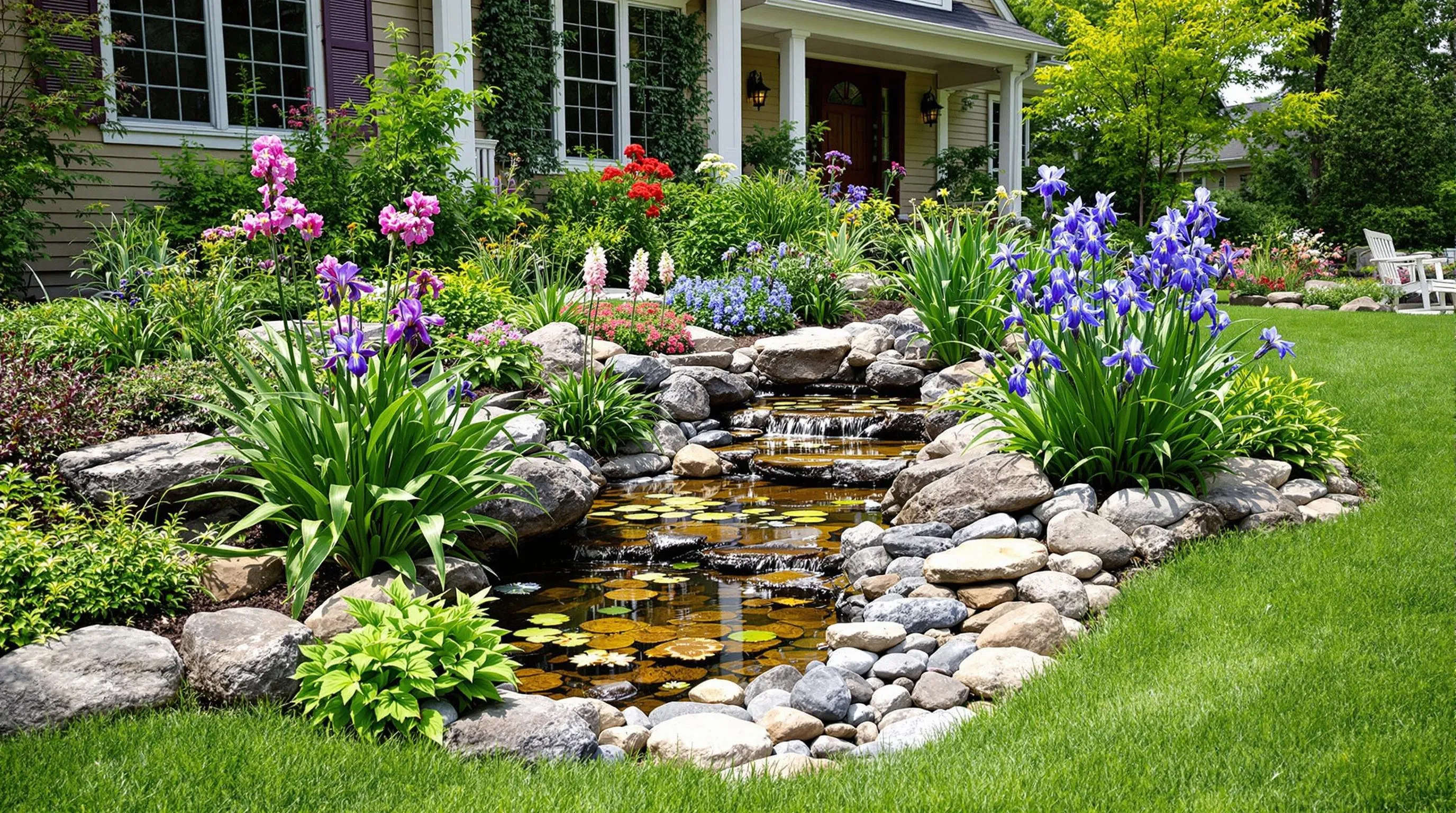
Rain gardens offer an eco-friendly solution to front yard landscaping, collecting rainwater runoff while creating a visually stunning focal point. These purposeful depressions are strategically designed to absorb water that would otherwise flow into storm drains, reducing erosion and filtering pollutants naturally.
Managing Runoff While Creating Beauty
Design your rain garden with a shallow basin positioned at least 10 feet from your home’s foundation to capture runoff from downspouts, driveways, or sloped areas. Create a berm on the downhill side using the excavated soil to help contain water during heavy rainfall. Layer your garden with materials that promote filtration—start with a base of gravel, add a mixture of sand and compost, and top with nutrient-rich soil. Incorporate decorative river rocks and smooth stones to create attractive drainage channels that guide water into the garden while preventing soil erosion. These functional elements double as design features, creating interesting textures and patterns that enhance your yard’s aesthetic appeal year-round.
Water-Loving Plants That Require Minimal Irrigation
Select plants based on your exact climate zone and the three distinct moisture zones within your rain garden. For the deepest center area that stays wettest, choose moisture-loving plants like blue flag iris, cardinal flower, and swamp milkweed. In the middle zone, plant versatile species such as black-eyed Susans, coneflowers, and switchgrass that tolerate both wet and dry conditions. For the outer edges that remain relatively dry, incorporate drought-resistant natives like little bluestem grass, butterfly weed, and prairie dropseed. Group plants according to height, with taller varieties in the back or center and shorter plants at the edges for maximum visual impact. This strategic planting approach creates a self-sustaining network that thrives primarily on natural rainfall, requiring supplemental watering only during extreme drought conditions. Your rain garden will attract beneficial pollinators while providing sophisticated visual interest through varying heights, textures, and seasonal blooms.
Conclusion: Embracing a Beautiful, Sustainable No-Grass Front Yard
Transforming your front yard with grass-free alternatives isn’t just a trend—it’s a smart investment in your property’s future. Whether you’re drawn to the Mediterranean allure of gravel gardens or the zen-like tranquility of Japanese rock arrangements, these options deliver stunning curb appeal with minimal upkeep.
The beauty of no-grass landscaping lies in its versatility. From productive edible gardens to elegant hardscaped patios, you’ll find answers that match your lifestyle while reducing water bills and maintenance hours. Your reimagined front yard will become a reflection of your personal style while contributing positively to the environment.
Ready to make the switch? Start with a small section and expand as you gain confidence. Your beautiful, sustainable front yard awaits—no mower required.





